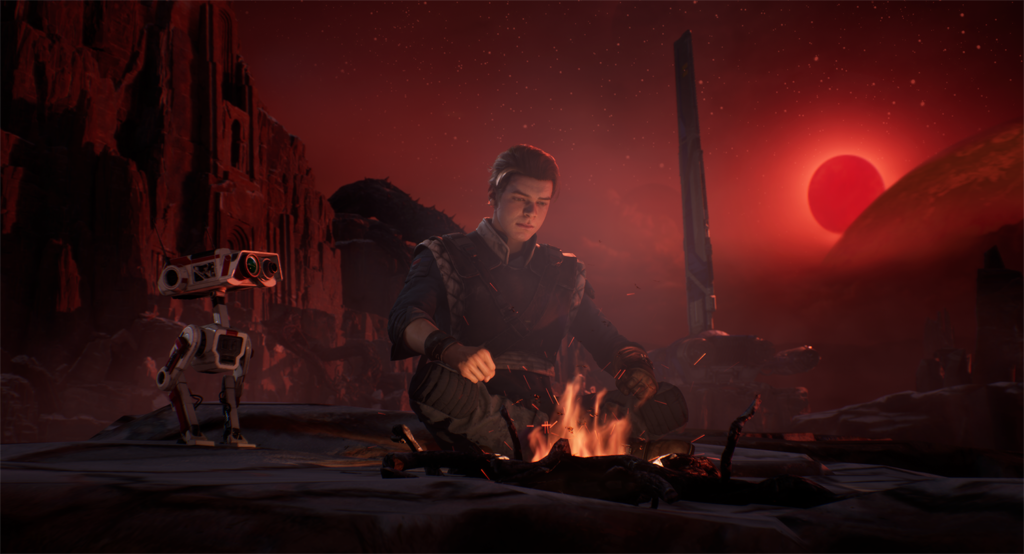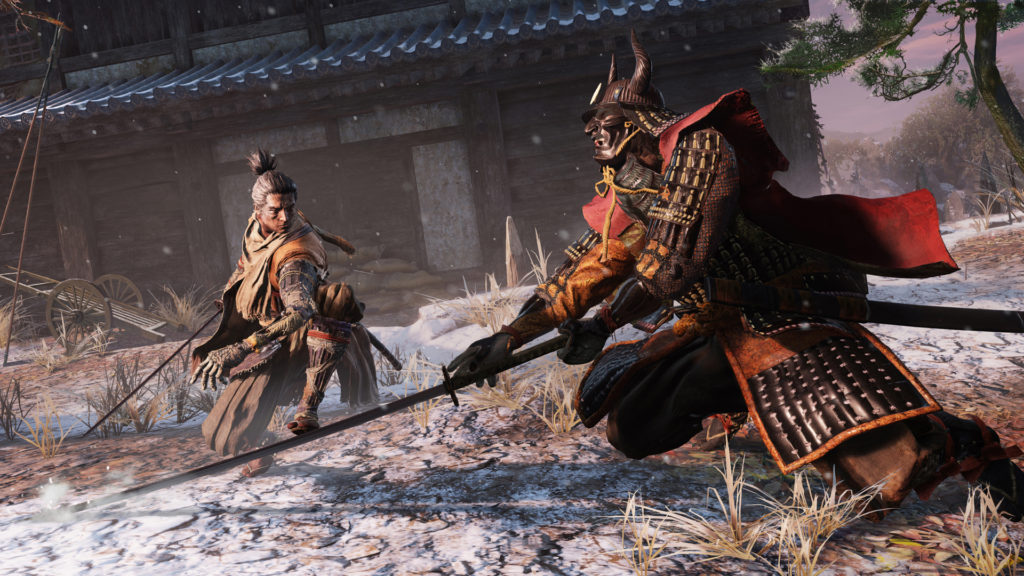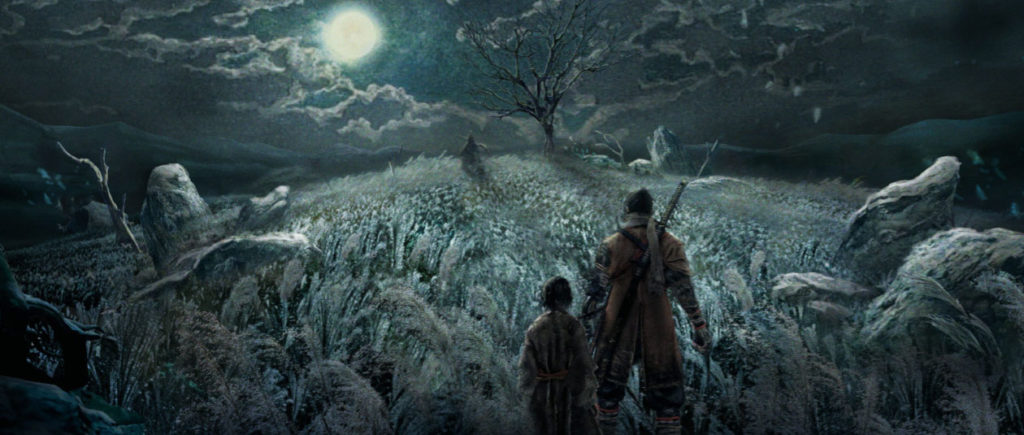
Jedi Fallen Order and Sekiro Shadows Die Twice: A Leap in the Dark and the Chaos of History
For years, when I thought I was a young man, I helped administer the sacrament (called communion in other religious groups) in my congregation. The sacrament meant the reinstitution of promises made when you became a member. It was another cleansing of sin. It was both a literal and metaphorical act. According to my leaders, I had been entrusted with God’s power, authorized by Them to pass out symbols of Their body to reinstitute literal promises to the divine. But it was also just a quiet moment, when one could promise to change, to do better next week. It is a ritual of personal redemption, albeit facilitated through an entire bureaucracy of authority.
Video games are full of these kinds of repetitions, from the daily schedules of Animal Crossing and Stardew Valley to the grind of bounties in Destiny, but they are rarely so filled with significance. Gaming’s rituals are ways to structure play, to enable satisfying effort and rewarding relief. Wrapping up a day’s bounties in Destiny or completing quests in Hearthstone lend you tangible rewards and straightforward goals to play around with. Superficially, at least, these loops do not gain any kind of metaphysical significance.
However, two games this year grant their loops potent, spiritual meaning: Sekiro: Shadows Die Twice and Jedi: Fallen Order. Both of these games owe their fundamental structure to Dark Souls. The world is hostile, outside of specially marked zones. Die in the world and you return to the last safe zone you rested. There are other safe spaces: Fallen Order has a ship you can hang out in and Sekiro has friendly NPCs. For the most part, though, the only reliable places of safety are these checkpoints. These places are meditative havens, marked with religious symbols, a Buddhist statue in Sekiro and a solar map in Fallen Order. The solar map might seem to carry less significance, decontextualized as it is from any explicit religious symbols. However, our very first introduction to the Jedi introduce the metaphysical “force” that “surrounds us, penetrates us [and] binds the galaxy together.” A solar map, with an individual at its center, showcases the principle of a bound and connected universe. Appropriately, they are more than just havens, they are also places of growth. They are places where a personal religious practice ripple out into the wider world. Though you might earn new abilities through experience and violence, you must return to these places to gain those abilities. It is not the swinging of the blade that defines your avatar’s strength, but the spaces between battles. It is an inner peace that enables power.

Your journey becomes defined by how far you are from the next safe place, like stops on a pilgrimage or stations of the cross. Since you do not know how far away the next checkpoint is, going outside is an act of faith. Players must stumble in the dark, learning the area, until their faith is rewarded with safety, only for it to be tested yet again as they leave. There’s been plenty of discussion about whether Sekiro or Fallen Order “count” as souls-likes, but this misses the point. Their usage of Souls’ structure results in a meditative ritual of combat. Respawning becomes an act of redemption. The structure mimics the process of reincarnation, whereby over multiple lifetimes of experience, perfection can be reached.
This practice of patience extends to the combat as well. Both Sekiro and, to a lesser extent, Fallen Order force their players to parry enemy attacks. This requires that the player quickly and calmly “reads” the enemy animation and responds with correct timing. Flailing or button mashing will only result in death. Every one of my failures in Sekiro came from panic; my victories came from serene knowledge. Sekiro’s chaos encourages serenity. Both of these games require that you remain mindful, deploying each swing and parry at the right time. They require the deliberate action that religious practice can provide.
Sekiro and Fallen Order’s roots in religion go deeper than feeling. The Jedi are effectively space samurai, given how much the Star Wars films draw from and appropriate the work of Akira Kurosawa (most obviously the film Hidden Fortress). The Jedi as serene spiritual warriors comes from that lineage. Sekiro’s explicit connection to religion is not hard to see, given that a major group of enemies are Buddhist monks and that the game is covered in Buddhist art and iconography. Both Sekiro and Fallen Order draw from the historical relationship between Samurai warrior culture and Buddhism.

To be clear, Star Wars’ usage of Buddhist thought is loose at best and harmfully appropriative at worst. The combination of Star Wars’ predominantly white cast and its interest in Christian modes of spirituality have thoroughly diluted its origins. I am not the critic to fully unpack this connection (ya’ll I am very white), but I want to emphasize the distance between Buddhism as practiced, Buddhism as depicted, and how it was filtered through a fantastical western lens, even as I use the connection to say that Fallen Order must, even if just through its lineage, make an argument about religion.
The most explicit way both Sekiro and Fallen Order make those arguments is through their protagonists’ relationship to the world. Cal Kestis, from Fallen Order, and Wolf, from Sekiro, are both among the last of their kind. Cal was a tween when the Jedi were purged. Now a young adult, a former Jedi tasks him with recreating the Jedi Order. He must find a map with a list of force-sensitive children, from which he can fill out its ranks. Wolf, on the other hand, was trained by the Shinobi old guard, but he remains fiercely loyal to Kuro, a divine heir who holds the key to immortality. When Wolf frees him from those who intend to exploit his powers, Kuro tasks Wolf with severing his tie to the heavens, and thus enabling him to live an ordinary life and die.
Wolf and Cal are driven from opposite ends. The world that Cal once knew was destroyed, and he would give everything to bring it back. Wolf, out of both loyalty and a knowledge of the terror of history, wants to undo what has been done. Both, though, are surrounded by the trappings of history. Their violent and meditative religious practice is a means of reconciling their past with their present. Both Cal and Wolf relive past events as a means of fully embracing their roles. Cal remembers past lessons to regain old powers, lost under the crushing weight of oppression. He can sense past events through the force, reliving the memories of those now gone. Wolf must recall past battles to grow stronger. In several sequences in Sekiro, Wolf returns to the past, to get items and/or knowledge that affect his current self. In Sekiro and Fallen Order, memory and history are the present. Thus, Cal and Wolf use their religious order as a way of cutting through the mess of history to create meaning for themselves. While narrative can be chaotic, Cal and Wolf both attempt to order it through their codes.

However, Fallen Order and Sekiro have an ambivalent relationship to religious order. The messy, but often transcendent, Star Wars prequels posit that the Jedi were an arm of a neoliberal police state. They were warriors who claimed not to be warriors, a political force that claimed not to be political, almost helpless before the rising tide of fascism that would destroy them. Fallen Order takes place soon after this loss. Furthermore, the game’s emotional stakes are wondering whether a reconstituted Jedi Order would just force another generation to live through the same loss Cal did. The iconography of Revenge of the Sith hangs over the game. By my count, the only two times the game borrows complete tracks from John Williams, it is quotations of Revenge. The death of the Jedi haunts the ravaged Star Destroyers, abandoned temples, and exploited natural world you explore. The knowledge that further deaths could result from trying to rebuild them results in the game’s most haunting and morose moments.
In kind, Sekiro offers up multiple corrupt institutions, that Wolf both destroys and embodies. It shares Dark Souls’ obsession with class. It depicts a village torn apart by the desire to reach the heavens and the false instructions of their religious leaders. The heavens themselves are inhabited by a narcissistic and indifferent noble class, who attempt to absorb Wolf’s youth and vigor. The aforementioned Buddhist monks have been swallowed by an obsession with immortality. Forgetting the Buddhist emphasis on the transient nature of self and suffering, they obsess over a narrow vision of power and control. The Buddhist sculptor who nurses Wolf back to health at the beginning of the game is Wolf’s dark mirror. Also a Shinobi, also missing an arm, he attempts to atone for his past life by crafting icons. However he says, “Every buddha I craft is an incarnation of wrath. I can only carve what I can see.” Even Wolf himself can be destroyed by dogmatism. Sekiro’s most haunting and violent ending requires strict adherence to the Shinobi’s Iron Code.
So while Sekiro and Fallen Order ask their players to live out a religious code, it also wants its players to consider the cost of that code. Cal and Wolf’s paths are quite literally marked in blood, defined by escaping from and entering into violence. Are we just repeating the sins of history? Both games answer with a kind of radical self-determination. In Wolf’s pursuit of an end to monarchy and history, he can erase himself to end his violence, and his code, or put into an entirely different use. Cal’s vision of a new Jedi Order becomes dramatically different and he refuses to rebuild what once lead to tragedy. It is notable that the games end as soon as world outside of the codes they create unfurls itself. How do you gamify peace? That is, real peace, not an internal calm used in service of violence? How do you create new rituals, new ways of being? Games as massive as Fallen Order or Sekiro do not have answers, but I appreciate their gestures. Cal and Wolf make true leaps of faith. Unlike before, there might be no space to catch them, the structures that defined them may have no space for them anymore. But they know that it better to choose one’s own path in the dark than to be in a lighted world with no path forward.

I’m a woman now and I don’t go to church anymore. My life is still filled with ritual. I work 9 to 5. I stream games Sunday mornings while the family above me attends church. While I don’t want to go to church, I long for the days when ritual and routine felt meaningful and freeing. My routines of work and play feel too loud and too busy to allow for peace and reflection. I too, long to reconcile my past with my present. I long to make rituals that structure a chaotic world, that make safe places in environments that threaten my demise. Neither Sekiro or Fallen Order are radical games, but they do offer a way to see through empty ritual, to true faith and change. After Wolf chooses to follow his heart, rather than the Iron Code, another swordsman tells him, “A true wolf would choose for himself how to use his fangs.” I do not know how to use my fangs, but I know they are my own. That the future is mine to carve, that safe spaces are mine to make, that my faith can help me get there. For now, I think of Cal lighting his saber in the midst of empire, not submitting. I think of Wolf leaping into the abyss, knowing that something will be there to catch him. I take a deep breath and live another day.






Like!! I blog quite often and I genuinely thank you for your information. The article has truly peaked my interest.
In this piece you reference Sekiro following his heart and breaking his code to give Lord Kuro the death he desires. Later, you make reference to “Sekiro’s most haunting and violent ending.” By choosing not to highlight the aspect of player choice in Sekiro you’re weakening the storytelling therein. It matters that the player gets to choose their path in that game, unlike in Fallen Order which is much more on rails narratively speaking. I think you make a great point here and you can use parts of Sekiro to support it, but others are in stark contrast to your opinion and if your reader has played through the multiple endings of Sekiro they know that as well.
You mention that neither of these games is “radical” yet, looking at one definition of the word I beg to differ. “Characterized by independence of or departure from tradition; innovative or unorthodox.” It is unorthodox for Wolf to go against the iron code just as it is for Cal to destroy the Holocron at the end of the game. I think both games are excellent examples of radicalism in the face of traditions or expectations forced upon both protagonists.